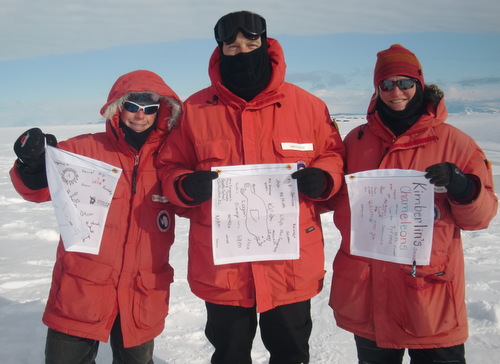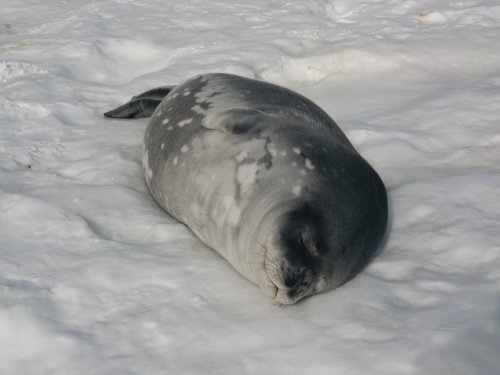This journal is brought to you by…
 Rachel, Gregg and Jenn holding three of your flags. Photo credit: Alex Eilers
Rachel, Gregg and Jenn holding three of your flags. Photo credit: Alex Eilers
- Mr. Jon House’s 3rd grade class at Riverwood Elementary
- Mrs. Ferguson’s 3rd grade class at South School
- Ms. Teresa Kimberlin’s 3rd grade class at Bon Lin Elementary School
The sounds of the Weddell seal are some of the most unusual I’ve ever heard from an animal!
In 1820, James Weddell (The man who the Weddell seal is named after) heard the Weddell seal and mistook it for a mermaid ‘making a musical noise.’ I’m not sure what mermaids sound like, but I love listening to these seals!
The amazing Weddell seal has inspired and intrigued explorers and scientists in Antarctica since they were first discovered in 1820! I can understand why – the Weddell seal is an awesome animal!
What does a seal look like when it’s making all that noise? Would the mouth of the seal be open?
Is this seal making a sound?
 Seal selfie. Photo credit: Alex Eilers, MMPA Permit # 17411
Seal selfie. Photo credit: Alex Eilers, MMPA Permit # 17411
Are these seals making a noise?
 I am seal, hear me roar? Photo credit: Alex Eilers, MMPA Permit # 17411
I am seal, hear me roar? Photo credit: Alex Eilers, MMPA Permit # 17411
 Can you hear me now? Photo credit: Alex Eilers, MMPA Permit # 17411
Can you hear me now? Photo credit: Alex Eilers, MMPA Permit # 17411
 Good morning, human scientists! Photo credit: Alex Eilers, MMPA Permit # 17411
Good morning, human scientists! Photo credit: Alex Eilers, MMPA Permit # 17411
Hmm, you would think so, but most of the unique sounds I’ve heard have come from seals looking like this:
 I wonder what the seals’ conversation is about? Photo credit: Alex Eilers, MMPA Permit # 17411
I wonder what the seals’ conversation is about? Photo credit: Alex Eilers, MMPA Permit # 17411
 Are these seals sunbathing or napping? Photo credit: Alex Eilers, MMPA Permit # 17411
Are these seals sunbathing or napping? Photo credit: Alex Eilers, MMPA Permit # 17411
 This looks like the happiest seal I’ve ever seen! Photo credit: Alex Eilers, MMPA Permit # 17411
This looks like the happiest seal I’ve ever seen! Photo credit: Alex Eilers, MMPA Permit # 17411
They look like they are sleeping! But, these seals are actually having quite a conversation! Are you surprised? I know I was! Seals don’t have to open their mouths when they are ‘talking’. Seals can vocalize and communicate with their mouths open or shut.
Sound names
Of all the seal species, Weddell seals are the most vocal. Weddell seals must like to talk a lot! Scientists have identified and named 34 different types of Weddell seal sounds. We hear the Weddells talking to each other quite a bit. Sometimes, they are so loud that you can hear them even when they are under the ice!
Scientists have come up with different names for these seal sounds - the names of the sounds are as unique and outrageous as the sounds themselves!
Here are a few examples:
- Chi-chi-chi
- Teeth clatter
- Mew
- Guttural glug
- Jaw claps
- Too-loo
- What-chunk
Check out this journal for some videos of seal sounds.
But what are these Weddell seals saying?
Most Weddell seal calls are used during social activities, like breeding. During breeding season, you can hear up to 20 calls per minute! Male Weddell seals are much more vocal than the female Weddell seals. Some calls that the male seals make are used to attract a female; other sounds are made to threaten another male. After the breeding season, Weddell seals are much quieter.
What does a Weddell seal sound like?
Weddell seals make the weirdest, eeriest sounds.
Take a listen!
Weddell seal sound 1
Recording credit: The Macaulay Library at the Cornell Lab of Ornithology, Recordist- Jeanette A. Thomas
Weddell seal sound 2
Recording credit: The Macaulay Library at the Cornell Lab of Ornithology, Recordist- Jeanette A. Thomas
What does it sound like to you?
These sounds are like something you would expect to hear in a science fiction movie! – You would never guess these noise were made by an animal - at least not an animal from Earth! Although the sounds are strange, I like them!
Antarctic Animal Sounds
Here are some sounds made by other animals that live near the Weddell seals:
Southern elephant seal
Recording credit: The Macaulay Library at the Cornell Lab of Ornithology, Recordist- Emiliano A. DepinoCrabeater seal
Recording credit: The Macaulay Library at the Cornell Lab of Ornithology, Recordist- Jeanette A. ThomasAntarctic fur seal
Recording credit: The Macaulay Library at the Cornell Lab of Ornithology, Recordist- Emiliano A. DepinoLeopard seal
Recording credit: The Macaulay Library at the Cornell Lab of Ornithology, Recordist- Thomas C. PoulterSouth polar skua
Recording credit: The Macaulay Library at the Cornell Lab of Ornithology, Recordist- Gregory F. BudneyAdelie penguin
Recording credit: The Macaulay Library at the Cornell Lab of Ornithology, Recordist- Jessie H. BarryHumpback whale
Recording credit: The Macaulay Library at the Cornell Lab of Ornithology, Recordists- Paul J. Perkins and Howard E. WinnKiller whale
Recording credit: The Macaulay Library at the Cornell Lab of Ornithology, Recordist- Donald K. LjungbladBlue whale
Recording credit: The Macaulay Library at the Cornell Lab of Ornithology, Recordist- Paul O. Thompson
How are these sounds different from the noises the Weddell seal made?
Do any of these noises sound similar?
Why do you think these animals make these sounds?
Why do you make sounds?
What is your favorite animal sound?


Comments